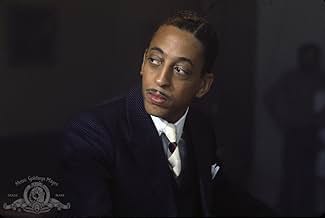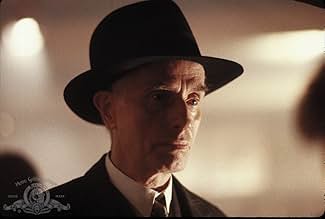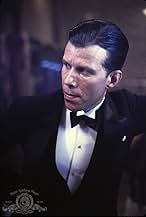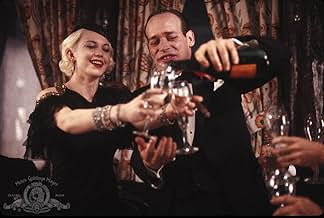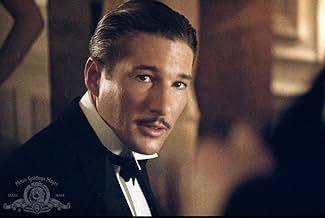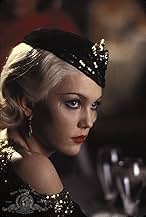VALUTAZIONE IMDb
6,6/10
20.595
LA TUA VALUTAZIONE
Il Cotton Club era un famoso nightclub di Harlem. Questa è la storia delle persone che hanno visitato questo club e delle persone che lo hanno gestito.Il Cotton Club era un famoso nightclub di Harlem. Questa è la storia delle persone che hanno visitato questo club e delle persone che lo hanno gestito.Il Cotton Club era un famoso nightclub di Harlem. Questa è la storia delle persone che hanno visitato questo club e delle persone che lo hanno gestito.
- Regia
- Sceneggiatura
- Star
- Candidato a 2 Oscar
- 1 vittoria e 9 candidature totali
Laurence Fishburne
- Bumpy Rhodes
- (as Larry Fishburne)
John P. Ryan
- Joe Flynn
- (as John Ryan)
Recensioni in evidenza
inspired by photographs of the legendary Cotton Club in Harlem, some shots appear exactly as they were (now in colour). I noticed Dutch Schultz's slumped pose when he is shot is exactly that of the police photograph, though he died several hours later (see William Burroughs "The Last Words Of Dutch Schultz"). The actors often play too broad (Diane Lane), and Richard Gere shows his lazy, grinning acting here too. However, many notable smaller roles for Gregory Hines (and his brother), Bob Hoskins, Laurence Fishburne and others who make it well worth watching. It is true that $40 million could have been used better, but when you consider both Bob Evans and Coppola's involvement it seems with hindsight that they were asking for trouble. The music deserves special credit, as do the tap sequences (which i gather were shortened and some cut - what a shame). Mostly Duke Ellington classics. As i've already suggested the look is a perfect recreation of the time, but sadly the plot is patchy, some dialogue weak and it has been said before - there is no chemistry between the romantic leads. 9/10
This is a great movie. I personally don't think the beautiful Diane Lane could be in a bad flick, she would make the worst one good. I was impressed with Richard Geres musical ability as he played his own coronet and sounded as good as anyone I've ever heard. The dancing was superb, the costumes beautiful and the plot authentic. It took me back to the great musicals of the forties and fifties. I was raised in the waning days of the era of this movie, the thirties, and I could almost hear my Dad talking about the evils of the big cities while we listened to the radio news of gangsters and shootouts. I would recommend this movie to anyone. I rate it 10/10.
One gets the sense that 'The Cotton Club (1984)' will improve upon repeat viewings, once you've become accustomed to what director Francis Ford Coppola was attempting. After all, this is a gangster film from the man who brought us 'The Godfather (1972)' and its sequels – what else could we expect but another Corleone saga? The film we're delivered is nothing of the sort, a testament to the director's constant willingness to take risks and experiment with new ideas. Indeed, rather than trying to emulate Coppola's former successes, 'The Cotton Club' could more accurately be described as a "gangster musical," a realisation that took me until the film's second half. Do those two genres even go together? Perhaps taking inspiration from Herbert Ross' 'Pennies from Heaven (1981)' – and the mini-series on which it was based – the film blends the ugly brutality and corruption of the Prohibition- era with the dazzling bright lights of the Cotton Club, Harlem's premiere night club. It is this deliberate but uneasy juxtaposition of reality and fantasy that fuels Coppola's vision, an ambitious undertaking without a dominant focus.
The film's major storyline concerns Dixie Dwyer (Richard Gere), a comparatively ordinary jazz musician who unexpectedly finds himself associating with organised crime boss "Dutch" Schultz (James Remar). Dixie is interesting because, unlike your typical hero consumed by the allure of amoral riches, he always remains peripheral to the world of gangsters; he observes, with disapproval, its dishonesty and depravity, but rarely finds himself a part of it. In fact, the closest he ever comes to being a gangster is in Hollywood, where he shares the sort of film roles that made James Cagney and Edward G. Robinson famous. Coppola might have been offering a commentary on the inherently romanticised version of reality offered by the movies, but his "real world" of gangsters is scarcely less stylised. The seedy underbelly of organised crime is paradoxically depicted as taking place in the classiest locales in Harlem, where the crime bosses consume the best alcohol and mix with Hollywood's elite talent (Chaplin, Swanson and Cagney among the featured patrons).
Proving further that Coppola wasn't attempting to replicate his Corleone saga, 'The Cotton Club' also features a rather extraneous subplot with Maurice and Gregory Hines as African-American tap-dancers vying for the "big-time" at the Cotton Club, where (in a bizarre discriminatory switch) only black performers are hired. The regular cross-cutting between this story and Dixie Dwyer's doesn't quite work, and, in any case, the taut romance between Dwyer and tough-girl Vera (an absolutely gorgeous Diane Lane) is much more involving than that between Sandman Williams (Gregory Hines) and mixed-race dancer Lila (Lonette McKee). Among the film's impressive supporting performers are Bob Hoskins and Fred Gwynne as crime associates, Nicholas Cage as an overly-ambitious young thug, Laurence Fishburne as black crime boss Bumpy Rhodes, and James Remar, playing a sleazier and less identifiable version of Dutch Schultz to Dustin Hoffman in 'Billy Bathgate (1991).' The premiere gangster film of 1984 was Leone's 'Once Upon a Time in America (1984),' but, despite being runner-up, nobody can accuse Coppola of playing it safe.
The film's major storyline concerns Dixie Dwyer (Richard Gere), a comparatively ordinary jazz musician who unexpectedly finds himself associating with organised crime boss "Dutch" Schultz (James Remar). Dixie is interesting because, unlike your typical hero consumed by the allure of amoral riches, he always remains peripheral to the world of gangsters; he observes, with disapproval, its dishonesty and depravity, but rarely finds himself a part of it. In fact, the closest he ever comes to being a gangster is in Hollywood, where he shares the sort of film roles that made James Cagney and Edward G. Robinson famous. Coppola might have been offering a commentary on the inherently romanticised version of reality offered by the movies, but his "real world" of gangsters is scarcely less stylised. The seedy underbelly of organised crime is paradoxically depicted as taking place in the classiest locales in Harlem, where the crime bosses consume the best alcohol and mix with Hollywood's elite talent (Chaplin, Swanson and Cagney among the featured patrons).
Proving further that Coppola wasn't attempting to replicate his Corleone saga, 'The Cotton Club' also features a rather extraneous subplot with Maurice and Gregory Hines as African-American tap-dancers vying for the "big-time" at the Cotton Club, where (in a bizarre discriminatory switch) only black performers are hired. The regular cross-cutting between this story and Dixie Dwyer's doesn't quite work, and, in any case, the taut romance between Dwyer and tough-girl Vera (an absolutely gorgeous Diane Lane) is much more involving than that between Sandman Williams (Gregory Hines) and mixed-race dancer Lila (Lonette McKee). Among the film's impressive supporting performers are Bob Hoskins and Fred Gwynne as crime associates, Nicholas Cage as an overly-ambitious young thug, Laurence Fishburne as black crime boss Bumpy Rhodes, and James Remar, playing a sleazier and less identifiable version of Dutch Schultz to Dustin Hoffman in 'Billy Bathgate (1991).' The premiere gangster film of 1984 was Leone's 'Once Upon a Time in America (1984),' but, despite being runner-up, nobody can accuse Coppola of playing it safe.
I saw this movie when it first came out and I thought it was a mess. Now years later while I have the luxury of sitting in my house watching the various showings on cable, I like a better. Why because this movie is IMO 3 different movies going on at once. I Now I am able to concentrate on one aspect of the movie more then the whole.
I will start with movie #1... The Cotton club, the nightclub where everything converges and what is the common denominator that brings ALL of the characters together. It is almost set up like a Plantation in Mississippi. The white gangster own the place and the black people work there and have no say about anything that goes on. Black people were not even able to go to the club as a customer. All of the women who worked there were light skin almost passing for white. In the movie they do show how the set up was but the place was no as large as it was in the movie and on a side bar. Larry Fishburn who plays a numbers runner (the same role he played in a later movie, Hoodlum) shows interest in a brown skin singer performer in the club and her mother is very upset because she is the first "dark skin" woman working at the club. I liked that they added that in. I know this because my neighbor use to play with Louis Armstrong that the women in question is in fact Louis Amstrongs future wife. A little tidbit. I like the music and the performances which took place in the club. To me this was the most enjoying part of the movie. I feel a movie just about the Club without all the other foolishness it would be very interesting in the right hands. Which brings me to movie 2
THe gangsters or the white people. Owey Madden was a thug and a very nasty man. In this movie Bob Hoskin (who was very good) and Fred Gwynn who I loved played like they were Fred Flintstone and Barney Rubble. In the right hands we would of seen the real Madden. Remember this is the man who kept black people out of his club. And did battle with other NY gangsters. Then we have Dutch Schultz. I wonder why we did not see more of Lucky Luciano because it was those 2 who were causing havoc in NYC during the 20's with Luciano winning. I think James Remer did the best portrayal of Schulz. Years later Tim Roth played him in the movie Hoodlum and he was good, but Remer was scarier. And according to all reports he was a psychopath. Then we have the George Raft(Dixie Dwyer) character played by Richard Gere If people are not familiar with the actor George Raft it was known he hung around the mob and had big time mob connections..who actually got him a job in movies. Richard Gere even mentions at one time that he use to be a dancer. I am sure that is reference and acknowledgment of George Raft, who was a dancer before he went to Hollywood. George Raft was actually a pretty good actor. Gere even looks like him. I feel that is the real reason they cast him in this movie. Look at this movie as Gere playing Raft and not playing Dixie Dwyer and the part works.
The last movie is the Harlem story. The Larry Fishburne character was a real person. He was lifetime criminal who spent most of his life in jail. He was not the voice of righteousness we see in the movie or the movie Hoodlum. What was interesting was the scene when he and the woman who was running the numbers racket in Harlem were offered a deal. I like they put that in the movie, that was true. The woman who was the real boss of the numbers racket came from the West Indies and started the whole thing on her own. A very tough cookie who went to jail because she would not give in to the mob. The mob was politically connected and they put her in jail for a long time. I like the the Hines bothers in the movie. They were feuding in real life and this movie was a way they starting talking again. They actually showed that in the movie. ALso the Vonnetta McGee character was interesting. I am a very light skin black women who could pas for white. WhICH I WOULD NEVER DO. But I don't know about living back in the early part of the century. The scene when she and Sandman goes to the hotel and the clerk tries to deny them a room actually happened to me and a boyfriend of mine years ago. So that scene really hit me. I would of liked if they explored Harlem life more, but the movie had too much going on already.
Nicholas Cage...nephew of Cappolla was good playing the violent brother of the Richard Gere character. I would like to have seen him in more parts like that instead of the garbage he has been wasting himself in the last few years. Diane Lane was the miscast. She was playing a real character too, but she came nowhere near the woman she was playing, Texas Guinon(I think that was her last name) A big boozy tough blonde. To me that is the major miscast of the movie. I like her though, but not in this movie. This is a movie I feel has to be seen around 5 times to get the whole feeling of it. A good movie but just too messy and too much.
I will start with movie #1... The Cotton club, the nightclub where everything converges and what is the common denominator that brings ALL of the characters together. It is almost set up like a Plantation in Mississippi. The white gangster own the place and the black people work there and have no say about anything that goes on. Black people were not even able to go to the club as a customer. All of the women who worked there were light skin almost passing for white. In the movie they do show how the set up was but the place was no as large as it was in the movie and on a side bar. Larry Fishburn who plays a numbers runner (the same role he played in a later movie, Hoodlum) shows interest in a brown skin singer performer in the club and her mother is very upset because she is the first "dark skin" woman working at the club. I liked that they added that in. I know this because my neighbor use to play with Louis Armstrong that the women in question is in fact Louis Amstrongs future wife. A little tidbit. I like the music and the performances which took place in the club. To me this was the most enjoying part of the movie. I feel a movie just about the Club without all the other foolishness it would be very interesting in the right hands. Which brings me to movie 2
THe gangsters or the white people. Owey Madden was a thug and a very nasty man. In this movie Bob Hoskin (who was very good) and Fred Gwynn who I loved played like they were Fred Flintstone and Barney Rubble. In the right hands we would of seen the real Madden. Remember this is the man who kept black people out of his club. And did battle with other NY gangsters. Then we have Dutch Schultz. I wonder why we did not see more of Lucky Luciano because it was those 2 who were causing havoc in NYC during the 20's with Luciano winning. I think James Remer did the best portrayal of Schulz. Years later Tim Roth played him in the movie Hoodlum and he was good, but Remer was scarier. And according to all reports he was a psychopath. Then we have the George Raft(Dixie Dwyer) character played by Richard Gere If people are not familiar with the actor George Raft it was known he hung around the mob and had big time mob connections..who actually got him a job in movies. Richard Gere even mentions at one time that he use to be a dancer. I am sure that is reference and acknowledgment of George Raft, who was a dancer before he went to Hollywood. George Raft was actually a pretty good actor. Gere even looks like him. I feel that is the real reason they cast him in this movie. Look at this movie as Gere playing Raft and not playing Dixie Dwyer and the part works.
The last movie is the Harlem story. The Larry Fishburne character was a real person. He was lifetime criminal who spent most of his life in jail. He was not the voice of righteousness we see in the movie or the movie Hoodlum. What was interesting was the scene when he and the woman who was running the numbers racket in Harlem were offered a deal. I like they put that in the movie, that was true. The woman who was the real boss of the numbers racket came from the West Indies and started the whole thing on her own. A very tough cookie who went to jail because she would not give in to the mob. The mob was politically connected and they put her in jail for a long time. I like the the Hines bothers in the movie. They were feuding in real life and this movie was a way they starting talking again. They actually showed that in the movie. ALso the Vonnetta McGee character was interesting. I am a very light skin black women who could pas for white. WhICH I WOULD NEVER DO. But I don't know about living back in the early part of the century. The scene when she and Sandman goes to the hotel and the clerk tries to deny them a room actually happened to me and a boyfriend of mine years ago. So that scene really hit me. I would of liked if they explored Harlem life more, but the movie had too much going on already.
Nicholas Cage...nephew of Cappolla was good playing the violent brother of the Richard Gere character. I would like to have seen him in more parts like that instead of the garbage he has been wasting himself in the last few years. Diane Lane was the miscast. She was playing a real character too, but she came nowhere near the woman she was playing, Texas Guinon(I think that was her last name) A big boozy tough blonde. To me that is the major miscast of the movie. I like her though, but not in this movie. This is a movie I feel has to be seen around 5 times to get the whole feeling of it. A good movie but just too messy and too much.
The Cotton Club is a dazzling, complex film that attempts so much it would be almost impossible for nearly any director to pull it off. But Francis Ford Coppola is not any director, so The Cotton Club is not just any movie. Rather, it succeeds at practically all levels and is certainly a film worth coming back to again and again.
Set in Harlem in the late 1920s, we are introduced to a group of Jazz Age-products, people who see themselves exactly as they are but all hope to go somewhere better. Two story lines occupy the plot; we get a good-looking young musician Dixie Dwyer (Richard Gere) who gets involved in the mob after falling for one of the gangster's girlfriends (Diane Lane) and we get the story of a very talented black dancer (Gregory Hines) trying to prove his love to a half-black and half-white chorus girl who seems to struggle with her place in this more or less racist society. Almost every night, everyone gathers at The Cotton Club, one of the most famous clubs in the city and the blacks entertain while the whites drink and watch. But Coppola gives us a view from all angles so it doesn't feel as if we are missing anything important.
One of the biggest achievements of this film is its staging of the dance sequences, which are to say the least quite exquisite. Filled with colorful costumes and some mind-boggling tap numbers, at times you may forget that this is also a gangster picture. Indeed, some scenes feel just like Coppola's The Godfather with its quick bursts of violence but also in its tone of sad, elegiac setting. People come and go and some regret the things they do, but the music lives on. The acting is also very strong as Gere and Lane are quite wonderful in their first of three films together. Both were very good-looking and they do bring out the best in each other. Two supporting actors that really do steal the show are Bob Hoskins and Fred Gwynne as a mob boss and his head bodyguard. They share a tenacity and ferociousness in their dealings, but also have one really terrific scene involving Gwynne coming to see Hoskins after being kidnapped. A young Nicolas Cage also shows here he had incredible potential.
This Broadway version of the gangster film so familiar in Hollywood refreshes both genres as we see the similarities between the two. Indeed, many of the participators in the entertainment were also involved in the mob and Coppola shows how the two lives intertwine and bring a lot of trouble to everyone. This may seem as a strange mixing of genres and story lines for some people, but it is well worth the two hours. It is funny, sad, violent, poetic but also enormously entertaining and isn't that what the movies are all about? Coppola seems to think so.
Set in Harlem in the late 1920s, we are introduced to a group of Jazz Age-products, people who see themselves exactly as they are but all hope to go somewhere better. Two story lines occupy the plot; we get a good-looking young musician Dixie Dwyer (Richard Gere) who gets involved in the mob after falling for one of the gangster's girlfriends (Diane Lane) and we get the story of a very talented black dancer (Gregory Hines) trying to prove his love to a half-black and half-white chorus girl who seems to struggle with her place in this more or less racist society. Almost every night, everyone gathers at The Cotton Club, one of the most famous clubs in the city and the blacks entertain while the whites drink and watch. But Coppola gives us a view from all angles so it doesn't feel as if we are missing anything important.
One of the biggest achievements of this film is its staging of the dance sequences, which are to say the least quite exquisite. Filled with colorful costumes and some mind-boggling tap numbers, at times you may forget that this is also a gangster picture. Indeed, some scenes feel just like Coppola's The Godfather with its quick bursts of violence but also in its tone of sad, elegiac setting. People come and go and some regret the things they do, but the music lives on. The acting is also very strong as Gere and Lane are quite wonderful in their first of three films together. Both were very good-looking and they do bring out the best in each other. Two supporting actors that really do steal the show are Bob Hoskins and Fred Gwynne as a mob boss and his head bodyguard. They share a tenacity and ferociousness in their dealings, but also have one really terrific scene involving Gwynne coming to see Hoskins after being kidnapped. A young Nicolas Cage also shows here he had incredible potential.
This Broadway version of the gangster film so familiar in Hollywood refreshes both genres as we see the similarities between the two. Indeed, many of the participators in the entertainment were also involved in the mob and Coppola shows how the two lives intertwine and bring a lot of trouble to everyone. This may seem as a strange mixing of genres and story lines for some people, but it is well worth the two hours. It is funny, sad, violent, poetic but also enormously entertaining and isn't that what the movies are all about? Coppola seems to think so.
Lo sapevi?
- QuizWhen Francis Ford Coppola called up Bob Hoskins to offer him a part, the actor didn't believe it was really him. Coppola introduced himself, to which Hoskins replied, "Yeah, and this is Henry the fucking Eighth", and hung up.
- BlooperDuring the montage song Ill Wind there is a shot of coins and bills being poured out. The dimes in the shot are Roosevelt dimes, not produced until 1946.
- Curiosità sui creditiIn the original version, the opening credits were intercut with dancers performing "The Mooche." In the 2019 revision, the dancing is eliminated and the credits roll straight through, but have been joined with straight cuts rather than dissolves. Additionally, Coppola has changed his billing from "Francis Coppola" to "Francis Ford Coppola." Finally, restoration credits have been added after the end titles.
- Versioni alternativeIn 2019, Lionsgate released a director's cut running 139 minutes, titled "The Cotton Club Encore". This version gave more space to the Williams brothers and Lila Rose, restoring three full musical numbers and extending others, and trimming scenes with impersonations of 1920s celebrities.
- ConnessioniEdited into Lonette McKee: Ill Wind (1984)
- Colonne sonoreHow Come You Love Me Like You Do?
Written by Gene Austin and Roy Bergere
I più visti
Accedi per valutare e creare un elenco di titoli salvati per ottenere consigli personalizzati
- How long is The Cotton Club?Powered by Alexa
Dettagli
- Data di uscita
- Paese di origine
- Lingue
- Celebre anche come
- El Cotton Club. Centro de la mafia
- Luoghi delle riprese
- Prospect Hall, Brooklyn, New York, New York, Stati Uniti(church, order given at bar, Hoofer's Club, ballroom proposal)
- Aziende produttrici
- Vedi altri crediti dell’azienda su IMDbPro
Botteghino
- Budget
- 58.000.000 USD (previsto)
- Lordo Stati Uniti e Canada
- 25.928.721 USD
- Fine settimana di apertura Stati Uniti e Canada
- 2.903.603 USD
- 16 dic 1984
- Lordo in tutto il mondo
- 25.928.721 USD
- Tempo di esecuzione2 ore 9 minuti
- Colore
- Proporzioni
- 1.85 : 1
Contribuisci a questa pagina
Suggerisci una modifica o aggiungi i contenuti mancanti

Divario superiore
By what name was Cotton Club (1984) officially released in India in English?
Rispondi


